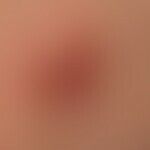Synonym(s)
HistoryThis section has been translated automatically.
Fox, 1880; Duhring, 1884. Duhring gave it the name dermatitis herpetiformis, which had previously been confused with chronic pemphigus and erythema exsudativum mulitforme by the Viennese school. The older French authors such as Bazin referred to it as small-bubble pemphigus or hydroa bullosa. The Frenchman Nodet separated it from true pemphigus as early as 1880 and gave it the name "pemphigoides polymorphous erythema". The English, following T. and C. Fox, the English preferred the name Hydroa herpetiformis. The connection with gluten sensitivity was still completely unknown in the 1950s (J Darier).
DefinitionThis section has been translated automatically.
Rare, gluten-sensitive, chronic autoimmune disease (autoantigens are both tissue transglutaminase (T2) and epidermal transglutaminase (T3)) with disseminated, occasionally also herpetiform, excoriated, bright red, 0.1-0.2 cm large, urticarial papules, papulovesicles and pure vesicles.
Severe forms are characterized by inflammatory plaques that can transform into flat, painful ulcers.
A burning or stinging"itch" is characteristic of the vesicular efflorescences. This form of "itching pain" is the main symptom that leads patients to the doctor. Stinging-burning pain is also a prominent feature of the ulcerative form of DhD.
The disease is understood as a cutaneous manifestation of(non-IgE-mediated) immunological gluten sensitivity(coeliac disease). While DhD is almost always accompanied by (often asymptomatic) coeliac disease, only a small proportion (around 3%) of coeliac disease patients have dermatitis herpetiformis.
Manifest intestinal symptoms are only observed in about 25% of dermatitis herpetiformis patients.
You might also be interested in
Occurrence/EpidemiologyThis section has been translated automatically.
The incidence of DhD is between 0.4 - 3.5 per 100,000 people per year and the prevalence is between 11.2 and 75.3 per 100,000. The higher rates are often found in countries such as Finland, as this disease is more common in people of Northern European descent. Conversely, DhD is rare in Asian populations (Makino T et al. 2019) and even rarer in African Americans.
DhD can occur at any age, but is most commonly diagnosed between the ages of 30 and 40, with a mean age of 43.
Men predominate with a ratio of 1.5:1-2:1 (Nguyen CN et al. 2021).
Overall, the incidence of DhD appears to be declining (?). This statement contrasts with the four-fold increase in the incidence of coeliac disease (Salmi TT 2019).
EtiopathogenesisThis section has been translated automatically.
Various triggers are discussed:
- Autoimmune disease with IgA antibody formation against epidermal transglutaminase (tGA), a key antigen in the endomysium.
- Frequently (95-100% of cases) there are associations with HLA class II molecules (DQ2). A smaller proportion (2-10%) serologically express the DQ8 haplotype. Deamidation according to the pattern characteristic of transglutaminase 2 (Q-X-P motifs) makes gliadin peptides more immunogenic, as they fit better into the HLA-DQ groove of antigen-presenting cells (Sollid LM et al. 2011). In this context, it is important to note that only HLA-DQ2.5, 2.2 and DQ8 can present gliadin peptides to T cells. This means that only patients with these genetic alleles can fall ill! This is the reason why coeliac disease is widespread in the Caucasian population, in the Arab population and in India. As HLA-DQ2 and DQ8 molecules are rare in African and Asian countries, for example, coeliac disease only occurs here in exceptional cases (Korponay-Szabô IR et al. 2015). HLA-DQ2 and DQ8 molecules require acidic residues at specific positions so that peptides can dock, which enables effective binding of gliadin-specific T cells.
- Associations with thyroid antibodies and/or thyroid disease(Hashimoto's thyroiditis).
- Detection of IgA antibodies against the autoantigen of coeliac disease(tissue transglutaminase). Circulating tissue transglutaminase antibodies support the diagnosis, but their absence does not rule out DhD (Salmi TT 2019). They are no longer detectable, especially after prolonged gluten abstinence!
- In addition, predisposing factors are frequently described, including:
- Particular sensitivity to halogens, especially iodine
- a focal event
- Malignant tumors or systemic diseases, especially B-cell lymphomas (in contrast to celiac disease, in which T-cell lymphomas - enteropathy-associated T-cell lymphoma are increasingly observed/Collin P et al. 2017).
- Changes in the jejunum villi (these are only detectable in around 1/4 of all DhD patients, which is consistent with the lack of intestinal sympotmia in most cases - Collin P et al. 2017).
In principle, celiac disease and DhD are initially based on the same pathomechanisms. In the case of genetic disposition (see above) and certain environmental factors, a systemic autoimmune disease develops with specific (IgA) antibodies directed against transglutaminases(Remarks: 6 isoenzymes of transglutaminases (Tg) can be found in the skin. Most of them play a role in keratinization! For example, mutations in the gene of transglutaminase 1 (TGM1) lead to lamellar ichthyosis). For unknown reasons, intestinal changes (in contrast to classic coeliac disease) in DhD often remain clinically asymptomatic initially and also in the later course of the disease (see also under symptomatic coeliac disease). In this respect, these patients do not adhere to a gluten-free diet! After several years of "unintentional but permanent gluten provocation", this "non-dietary behavior" leads to the formation of high-affinity AK against transglutaminases (TG). The antibodies occurring in the serum form immune complexes with both the epidermal transglutaminase (Tg3) and the tissue transglutaminase (Tg2)(IgA-TG isoenzymes). These immune complexes circulate and can be deposited in the renal glomeruli (possible development of IgA nephropathy) as well as in lesional and healthy skin (papilla tips, basement membrane). There they can be detected immunohistologically (direct immunofluorescence) as granular, linear or even discontinuous fluorescence in the papilla tips.
It is noteworthy that in patients with coeliac disease, IgA deposits can also be detected in non-inflammatory skin. These immunological findings contradict the unitary etiopathogenetic significance of papillary immune complex deposits for the dermal inflammation of DhD (Antiga E et al. 2019). Together with other gluten-induced diseases, celiac disease and DhD are grouped under the umbrella term gluten-sensitive diseases (GRD).
ManifestationThis section has been translated automatically.
Occurrence is possible at any age. Affected are mainly adults between the ages of 25-55 years. Men are affected slightly more often than women (M:F = 6:4).
Children are rarely affected.
LocalizationThis section has been translated automatically.
Mostly symmetrical distribution pattern.
Mostly affected are the upper shoulder girdle (sometimes in acneiform distribution), gluteal region, capillitium, extensor sides of the forearm, elbow regions, extensor sides of the thigh and lower leg, knee regions.
Less frequently affected are the face and ear region (also in the external auditory canals).
Mucous membranes are usually free. However, aphthous, painful erosions of the oral and genital mucosa are (rarely) observed.
Occasionally, although rarely, "herpes simplex-like" lesions of the labial redness are found.
ClinicThis section has been translated automatically.
Sudden, rarely also slowly insidious, onset with disseminated, symmetrical, intensely pruritic/burning or stabbing-painful, 0.1-0.2 cm large, urticarial erythema. Within these erythemas, grouped papules and/or vesicles form. The vesicles erode relatively quickly, leaving a small crusty papule.
There is the development of a "synchronous polymorphism" with vesicles, wheals, papules, crusted small erosions due to the relapsing nature of DhD, as well as prolonged and therapy-resistant ulcers and scars of varying sizes. This variegated pattern of efflorescences is mainly found on the elbows and buttocks. Aphthous oral or genital mucosal lesions may be observed, although rarely.
An extremely chronic course is characteristic. Relapses last from one month to more than 1 year. Intermissions may last weeks to years. Extension and intensity vary within wide limits. A minimal morphologic variant may be a skin completely free of symptoms with attack-like itching, a finding that poses differential diagnostic problems.
In cases of pronounced gluten sensitivity, dietary errors can lead, after hours or days, to acute relapsing activity with pruritic to painful, highly red urticarial exanthema, possibly combined with rhinopathic and bronchitic symptoms. Chronic enteropathy is possible but not obligatory (signs of celic disease).
On the other hand, the (rare) dermatitis herpetiformis in childhood has a close clinical correlation to a gluten-sensitive enteropathy (sprue) .
LaboratoryThis section has been translated automatically.
In some cases blood eosinophilia.
Antibody detection:
- Anti-gliadin-AK, anti-endomysium-AK, AK against tissue transglutaminase.
- AK against epidermal transglutaminase (most sensitive serological test for confirming the diagnosis).
- Note: after months on a gluten-free diet (GFD), the antibody levels decrease and can also become completely negative.
However, experience shows that there are also cases of serologically primary negative cases of DhD.
HistologyThis section has been translated automatically.
Formation of subepidermal clefts to vesicles; blistering occurs below the lamina densa.
In the initial stage (urticarial stage), an infiltrate of neutrophilic granulocytes forms in the upper and middle dermis with focal epidermotropy. There is also leukocytoclasia in places.
In the blistering stage, neutrophilic and eosinophilic granulocytes form intrapapillary microabscesses that are nearly pathognomonic but not always detectable (serial sections). Frequent necrosis of basal epidermal cells.
In the mature subepidermal blister stage, there is an increasingly lymphocytic infiltrate with numerous neutrophilic granulocytes at the base of the blister as well as at the lateral edge of the blister. Eosinophilic granulocytes are in the minority.
Small bow el biopsy: Collection of small bowel mucosal biopsies is not required in the diagnosis of DH. When it is nevertheless performed, villous atrophy is seen in the majority of patients, and celiac-type inflammation is present even in patients with normal villous architecture (Salmi TT 2019).
Direct ImmunofluorescenceThis section has been translated automatically.
Fine granular deposition of IgA and complement, mostly continuous along the dermo-epidermal junction, but also focally in the papillary tips; detection in both affected and unaffected skin. IgA transglutaminase immune complexes can also be detected in the wall of small vessels.
DhD with fibrillar deposition of IgA immune complexes in papillary dermis has been described in Japanese patients ( Makino T et al. 2019).
Indirect immunofluorescence (after ruling out an IgA -deficiency): Detection of IgA-AK against transglutaminase 3, endomysium IgA-AK, AK against gliadin and possibly thyroid AK, and AK against parietal cells.
DiagnosisThis section has been translated automatically.
Direct immunofluorescence (DIF) is the diagnostic gold standard of DhD with a sensitivity of 90-95% and a specificity of 95-100%. Biopsies should be taken from uninvolved perilesional skin, as these regions contain significantly more IgA deposits and lesional biopsies generally have a higher false-negative rate. The pathognomonic finding in DIFs is granular IgA deposits in the dermal papillae and/or at the dermoepidermal interface.
However, DhD with IgA deposits exclusively along the dermoepidermal interface may be confused with linear bullous IgA dermatosis, in which case further serologic testing is required.
Less frequently, a fibrillar pattern of IgA deposits has been described in the skin tips of DhD patients. This pattern differs from the granular pattern in that the IgA deposits appear as linear streaks rather than fine granules. The fibrillar pattern is more common in Japan, where it can be found in up to 50% of patients.
In addition to IgA, IgM and C3 have also been detected at the dermal papillae and dermoepidermal interface.
If a patient with high clinical suspicion of DhD has a negative DIF result, consideration should be given to repeating the biopsy from a new, "normal" appearing, perilesional skin site. False-negative results occur in approximately 5% of biopsies. Note: A strict gluten-free diet may decrease IgA levels in the skin, which also affects DIF results, in contrast to pharmacological treatments that do not alter IgA deposition.
In this respect, the patient's diet must also be evaluated in IF diagnostics. If the patient is following a strict gluten-free diet, biopsy should be performed again after one month on a "normal" gluten-containing diet. In rare cases, even a rebiopsy in DhD patients may not lead to the desired result. In this case, the combination of clinical, histopathological and serological data must be used to establish the diagnosis.
Differential diagnosisThis section has been translated automatically.
Bullous pemphigoid: Elderly people, large subepithelial blisters, preferred on the flexural side; detection of AK against basement membrane antigens.
Pemphigus vulgaris: easily injured intraepithelial blistering, formation of autoantibodies against desmoglein 3 (Dsg 3) or desmoglein 1 (Dsg 1-s.u. DSG1 gene).
Erythema multiforme: Eruptive course, cockade structures, often mucosal infestation. Blistering possible (large blisters)
Incontinentia pigmenti: X-linked dominant hereditary, neuroectodermal disease of childhood, present at birth or occurring within the first week of life (almost 100%), with infestation of skin, nails, hair, teeth and eyes.
IgA-linear dermatosis: Rare, chronic, autoimmunologic, blistering dermatosis (large blisters) with linear IgA and C3 deposition at the dermo-epidermal junction zone, which belongs to the pemphigoid group.
Chronic urticaria: frequent, acute or acutely recurrent disease with typical, short-lived wheal formation.
Complication(s)(associated diseasesThis section has been translated automatically.
Enteropathy: Most patients with DhD have evidence of some degree of celiac-like damage in their small intestine; however, this is usually milder than in celiac disease (CD). Consequently, patients with a history of DH may present with GI symptoms such as bloating, diarrhea or constipation, but these are usually minor.
Due to the association with gluten-sensitive enteropathy, patients with DhD may experience complications of malabsorption such as nutrient deficiency, osteoporosis, short stature, anemia and weight loss. However, in contrast to coeliac disease, these are rare in DhD. Furthermore, coeliac disease-related complications such as ulcerative ileitis or non-Hodgkin's lymphoma as well as malignant diseases of the gastrointestinal tract can also develop.
As with coeliac disease, a diagnosis of DhD is associated with a significantly increased risk of non-Hodgkin's lymphoma. However, this risk is only increased in the first five years after diagnosis. Both T-cell and B-cell lymphomas have been reported, with B-cell lymphomas being more common.
Neurological dysfunction: In rare cases, gluten sensitivity has been associated with neurological dysfunction such as cerebellar ataxia, polyneuropathies, epilepsy, myelopathy and encephalopathy. Case reports have described that DhD is associated with various neurological pathologies. The incidence rates of these conditions have not been studied in DhD but are thought to be low. Nevertheless, dermatologists should be aware of this association and refer to a neurologist if necessary.
Autoimmune and associated diseases: There are associations between a diagnosis of DhD and a variety of other autoimmune diseases, the most common being autoimmune thyroid disease and type I diabetes mellitus. Other less common conditions include pernicious anemia, multiple sclerosis, Sjögren's syndrome, SLE, rheumatoid arthritis, vitiligo, alopecia areata, dermatomyositis, sarcoidosis, Addison's disease, psoriasis and atopic dermatitis. Most clinicians can easily screen patients with DhD for thyroid disorders (TSH, T3, T4 and anti-thyroid peroxidase) and type 1 diabetes (serum glucose) and should test for other autoimmune disorders based on associated signs and symptoms.
DhD is also associated with an increased risk of bullous pemphigoid . The diagnosis of DhD and subsequent diagnosis of BP have been reported at different intervals. Therefore, dermatologists should be alert to the possibility of a new diagnosis of bullous pemphigoid if the clinical picture changes due to the formation of large blisters and/or a gluten-free diet is no longer effective (Nguyen CN et al. 2021).
TherapyThis section has been translated automatically.
Diet and substitution of vitamins and iron:
- Consistent gluten-free diet: The treatment of choice for DH is strict, lifelong adherence to a gluten-free diet. In addition to relieving the symptoms of DH and healing the small intestinal mucosal damage, a gluten-free diet increases patients' quality of life and reduces the risk of lymphoma in DH (Salmi TT 2019).
- With a gluten-free diet, about 1/3 of all patients remain symptom-free without therapy. Avoidance of all grain products (barley, oats, rye, wheat). Even in the absence of signs of celiac disease (steatorrhea), villous atrophy can be histologically confirmed in most patients.
- Low iodine diet: No iodized salt, no sea fish, few dairy products, selected sausage and meat products (as often treated with iodized salt), no iodine-containing drugs.
- Drug of 1st choice is still dapsone; dosage: 50-150 mg/day to max. 300 mg/day (e.g. dapsone-fatol), Cave! Met-Hb formation! Determine glucose-6-phosphate dehydrogenase before starting therapy! After symptoms have subsided, minimum maintenance dose for years. Attempt to discontinue after 6 months at the earliest.
- alternatively colchicine: in case of sulfonamide intolerance colchicine (e.g. colchicine dispert) 3 times 0.5 mg/day.
- alternative: in refractory cases try ciclosporin A (e.g. Sandimmun Optoral) 5 mg/kg bw/day, if necessary increase dose to 7 mg/kg bw/day.
- In severe pruritus, antihistamines such as desloratadine (e.g. Aerius) 1-2 tbl/day. In gluten-induced enteropathy, treatment by internist, good effect can be achieved with sulfasalazine (e.g. Azulfidine) in medium dosage (3-6 g/day).
-
Iron substitution: Hb deficit in g/l × 25 = total iron requirement in mg.
- Perorally: (e.g. Ferro sanol duodenal) 2(-3)times 50 mg/day, later 2(-3)times 100 mg/day p.o. preferably on an empty stomach.
- Intravenously: (e.g. Ferrlecit) rarely necessary, adults 3.2-5.0 ml/day i.v. slowly.
- Intramuscular: (e.g. Ferrum Hausmann) adults 4 ml/day i.m., infants: 5 mg/kg bw/day p.o., spread over 3 ED over 3 months. Intramuscular administration in infants (e.g., Ferrum Hausmann): Zigzag injection (skin pigmentation!). Hb deficit (age norm) × bw (in kg) × 3.5 = iron requirement in mg. 1-2 ml i.m. every 2nd day. Caveat. No concomitant administration with tetracyclines, antacids, colestyramine, penicillamine.
- Vit. B12 substitution (e.g., Neurotrat B 12): Induction with 1000-2000 μg/week i.m., i.v., or s.c. Reticulocytes increasing after 5-8 days. Maintenance dose: 100-300 μg every 2 months.
- Folic acid substitution (e.g., folic acid-Hevert): 5-15 mg/day p.o. Children: 5-10 mg/day p.o. for 4 weeks or 0.2 mg/day parenterally for 4 weeks.
- Vit. D substitution: Vit D3 (Dekristol, Vigantoletten): 5000-10,000 IU/day p.o. for 6 weeks, later 2000-5000 IU/day for several months. Calcium supplementation (4 times/day 250 mg p.o.) is essential.
- Experimental: In individual cases, the use of antibiotics can produce significant positive effects. For example, the penicillinase-resistant beta-lactam antibiotic flucloxacillin is also effective in medium or low doses.
External therapyThis section has been translated automatically.
Antipruriginous treatment e.g. with 3% Polidocanol cream (e.g. Thesit or as a formulation: Polidocanol cream 2-5%).
S.a.u. Antipruriginosa. In case of a highly inflammatory character short-term or intermittent weak or moderately strong glucocorticoid creams/emulsions like 0.05% betamethasone lotio (e.g. Betagalen, R030 ).
TablesThis section has been translated automatically.
Gluten- and iodine-free diet for dermatitis herpetiformis Duhring
Food |
allowed |
prohibited |
Bread |
Potato, corn, rice, soybean flour |
all kinds of bread, pastry and cakes made from common cereals see above |
fruit |
all species |
|
Vegetables |
all species |
|
|
Dairy products (little about iodine) |
natural dairy products such as fresh milk, natural yoghurt, kefir, soured milk, buttermilk, cream |
Fruit yoghurt (often contains undeclared binders), grain yoghurt |
Grease |
animal fats, margarine, coconut fat, sunflower oil, safflower oil, corn oil, pure mayonnaise |
Wheat germ oil, marinades and sauces made with flour |
Binders |
corn starch (e.g. Mondamin), potato starch |
Noodles |
Meat |
pure meat |
meat products prepared and stretched with pasta, products pretreated with iodine salt |
Spices |
all spices except |
Iodine salt |
Cheese |
all cheeses except |
Processed cheese, other forms of processed cheese which may contain added starch |
Desserts, sweets |
Pudding made from permitted flour types, starch, gelatine, sweets, jam/jelly, jam, honey, Nutella, chocolate without cereal additives |
cakes, tarts, puddings, finished products made from cereal flour |
Beverages |
all fruit juices, mineral water, tea, coffee, wine, cocoa, corn beer |
all types of beer (except corn beer) |
Diet/life habitsThis section has been translated automatically.
In a patient with long-standing "dyshidrotic vesicles" which were very strongly hemorrhagic, Mr. Rose was able to prove histologically and serologically a dermatitis herperiformios. After precise instruction on a gluten-free diet, the patient ordered a fish dish on the plane, after which a severe flare-up occurred. In the meantime he reacts so strongly to iodine that he can only tolerate Irish meat, because only this is fed without iodine salt.
Note(s)This section has been translated automatically.
Diagnosis:
- Clinic, histology (papillary microabscesses).
- Jejunum biopsy
- Immunohistology (detection of granular deposited IgA complexes at the dermo-epidermal junction).
- Serological antibody detection (see above).
LiteratureThis section has been translated automatically.
- Antiga E et al (2019) Dermatitis Herpetiformis: Novel Perspectives. Front Immunol 10:1290.
- Boenrieder T et al. (2003) From the New World. Louis A. Duhring and Dermatitis Herpetiformis. Dermatology 54: 167-172
- Collin P, Reunala T (2003) Recognition and management of the cutaneous manifestations of celiac disease: a guide for dermatologists. Am J Clin Dermatol 4: 13-20
- Collin P et al. (2017) Dermatitis herpetiformis: a cutaneous manifestation of coeliac disease. Ann Med 49:23-31.
- Duhring LA (1884) Dermatitis herpetiformis. Journal of the American Medical Association 3: 225-229
- Fox WT (1880) A clinical study of the hydroa. Archives of Dermatology 6: 16-52
- Hervonen K et al. (2014) Dermatitis herpetiformis in children: a long-term follow-up study. Br J Dermatol 171:1242-124
- Kadunce P et al. (1993) The effect of an elmental diet with and without gluten on disease acitivity in dermatitis herpetiformis. J Invest Dermatol 97: 175-182
- Kotze LM (2013) Dermatitis herpetiformis, the celiac disease of the skin! Arq Gastroenterol 50:231-235
- Makino T et al (2019) Fibrillar-type dermatitis herpetiformis. Eur J Dermatol 29:115-120.
- Marietta EV et al. (2008) Transglutaminase autoantibodies in dermatitis herpetiformis and celiac sprue. J Invest Dermatol 128:332-325.
- Misri R et al. (2019) Atypical manifestations of disseminated cutaneous botryomycosis mimicking dermatitis herpetiformis in an immunocompetent adult woman.Indian J Dermatol Venereol Leprol 85:511-513.
- Murphy LA et al. (2003) Dermatitis herpetiformis converting into bullous pemphigoid: a study of three cases. Br J Dermatol 149 (Suppl 64): 17
- Nicolas ME et al (2003) Dermatitis herpetiformis. Int J Dermatol 42: 588-600
- Nguyen CN et al (2021) Dermatitis Herpetiformis: An Update on Diagnosis, Disease Monitoring, and Management. Medicina (Kaunas) 57:843.
- Reunala T et al. (2021) Dermatitis Herpetiformis: An Update on Diagnosis and Management. Am J Clin Dermatol 22:329-338.
- Rose C et al. (2010) Clinic, histology and immunopathology in 32 patients with dermatitis herpetiformis Duhring. JDDG 8: 265-271
- Salmi TT (2019) Dermatitis herpetiformis. Clin Exp Dermatol 44:728-731
- Sardy M et al. (2002) Epidermal transglutaminase (TGase 3) is the autoantigen of dermatitis herpetiformis. J Exp Med 195: 747-757
- Sardy M et al (2009) Dermatitis herpetiformis. Dermatology 60: 627-632
- Smith AD et al. (2002) Neutrophil CD11b, L-selectin and Fc IgA receptors in patients with dermatitis herpetiformis. Br J Dermatol 147: 1109-1117
Incoming links (55)
Anti-p105 pemphigoid; Autoimmune dermatoses, bullous; Betamethasone valerate emulsion hydrophilic 0,025/0,05 or 0,1 % (nrf 11.47.); Bubbles; Buckwheat; Buckwheat; Cadexomer iodine; Dadps; Dermatite polymorphic douloureuse; Dermatitis exudative discoid lichenoid; ... Show allOutgoing links (50)
Addison's disease; Alopecia areata (overview); Antihistamines, systemic; Antipruriginosa; Atopic dermatitis (overview); Autosomal recessive ichthyosis lamellosa with transglutaminase deficiency; Bazin, ernest pierre antoine; Betamethasone valerate emulsion hydrophilic 0,025/0,05 or 0,1 % (nrf 11.47.); Bubbles; Bullous Pemphigoid ; ... Show allDisclaimer
Please ask your physician for a reliable diagnosis. This website is only meant as a reference.





































